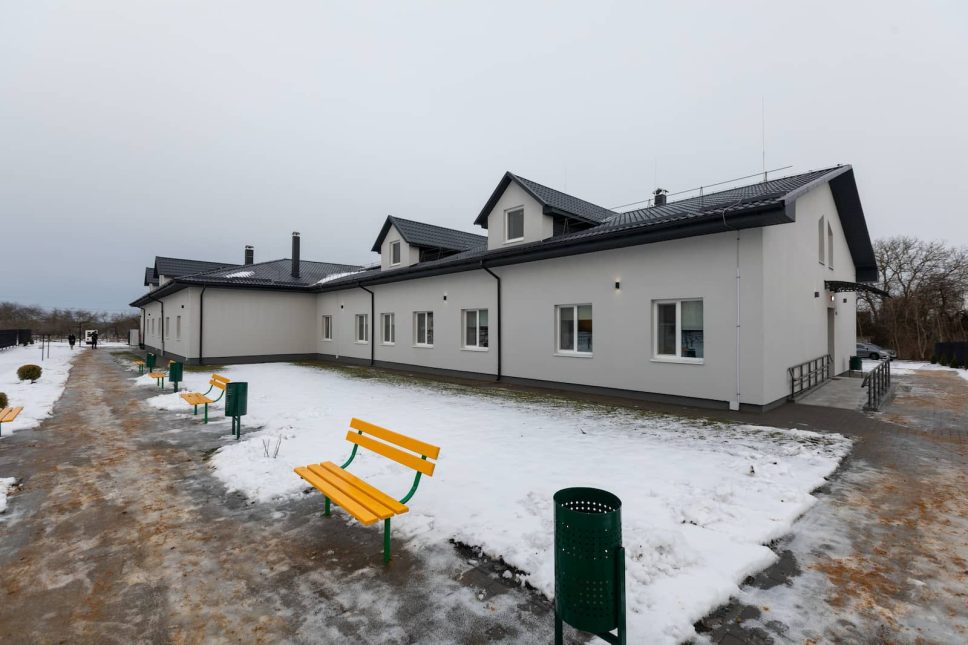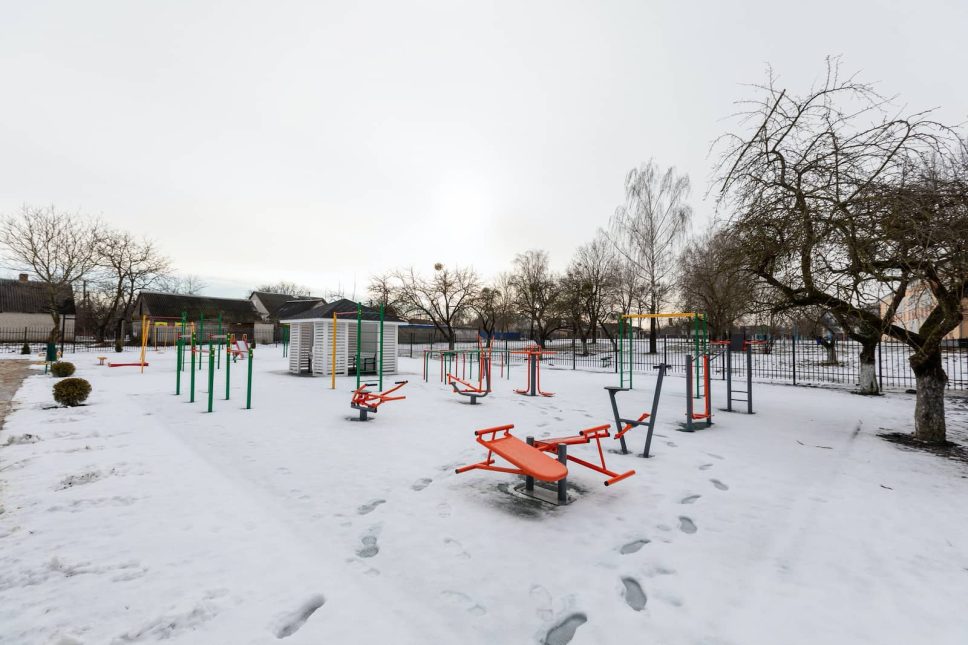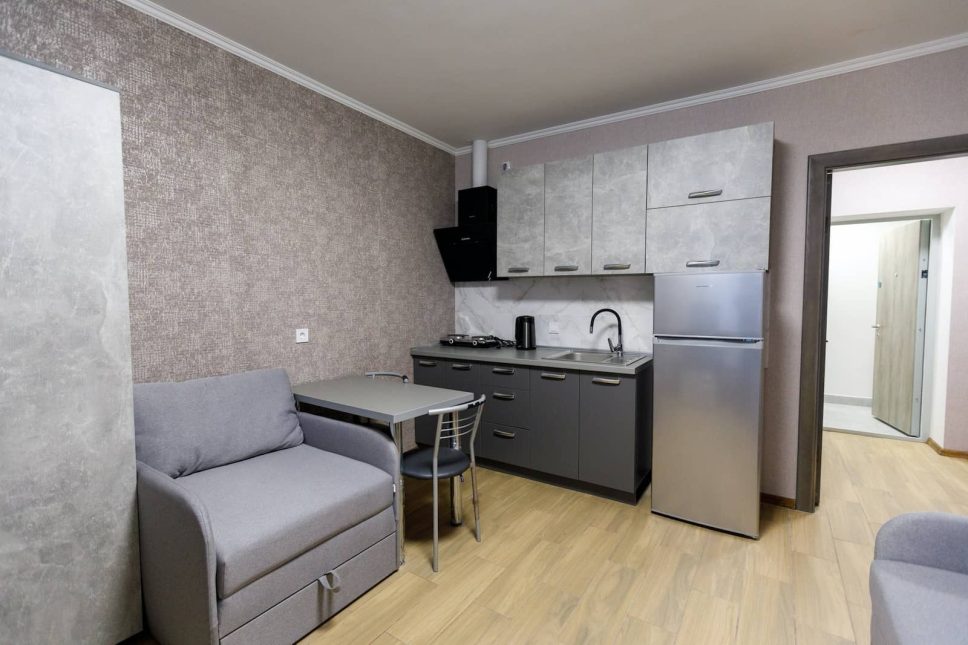
A new life for IDPs: how a Nefco and EU housing project transformed Ukraine’s Kivertsi community
12/02/2024
The energy efficient reconstruction of a former boarding school dormitory provides urgent housing for displaced Ukrainians in the community of Kivertsi under a programme funded by the EU and managed by Nefco.
Kivertsi is a town located in northwestern Ukraine, approximately 12 km from the regional centre, Lutsk. It serves as the administrative centre of the Kivertsi territorial community, with a total population of around 18,000 people. Despite its small size, the community received more than 3,000 internally displaced persons (IDPs) at the onset of the full-scale invasion by Russia, highlighting the urgency of addressing their housing needs.
Municipal authorities had wanted to reconstruct the building for many years, but they were unable to implement the project earlier. However, thanks to the programme “EU Support for Urgent Housing Needs for Internally Displaced Persons in Ukraine,” funded by the European Union and managed by Nefco, this idea finally materialised. The programme’s total budget is EUR 19.4 million, with around EUR 1.5 million earmarked for the reconstruction of the dormitory in the village of Trostianets, within the community of Kivertsi.

Apart from fulfilling the needs of IDPs, the project brings significant benefits to the entire Kivertsi community. The introduction of best green practices and standards means that heating and maintaining the building will incur less expenses from the municipal budget.
“The restoration of this building is important because it is a good facility that includes a bomb shelter and a canteen open to everyone,” explains Oleksandr Kovalchuk, Head of the Kivertsi City Council. “What once was an abandoned building has now become one of the greenest buildings in our community, thanks to our cooperation with the European Union and Nefco. Now, many internally displaced families with children can live in these well-functioning apartments under favourable conditions. They can start their new lives here, finding employment in our community.”
On 24 January, the renovated dormitory welcomed its first residents. Among them is Illia, a native of Chasiv Yar in the Donetsk region, where he lived with his brother and sister. Only seven months have passed since they left the heavily shelled city, moving to a temporary shelter for IDPs in the village of Stavok, situated between Rivne and Lutsk. After finding a job at the local hotel, the three moved into its staff room, where they lived until they received a key to an apartment in the refurbished building.

Illia expects that a new home will give him and his siblings a sense of stability. “We are unlikely to go back to Donetsk because there may be nowhere to return to. Getting an apartment is very important for us. When I came here with nothing, I didn’t know what was waiting for me or if I could have something of my own. We expect the new apartment to become our permanent accommodation, because not knowing where we will wake up next month is scary. I hope that we can live comfortably here for a long time.”
Ivan also hails from the Donetsk region, from Bakhmut. Despite the outbreak of hostilities, he remained there, volunteering and helping people until the day he came under shelling and lost his arm. Following hospital treatment, Ivan found a place to stay in Kivertsi and has lived in the community for about a year.
Satisfied with the conditions in his new apartment, he strongly believes in the significance of housing projects for IDPs. “Such initiatives are crucial for Ukraine because many people lost their homes. I stay in touch with many of my Bakhmut neighbours scattered throughout the country. The last pictures I saw of our house, a high-rise building, showed it half-destroyed. We have nowhere to return to; therefore, I will settle here.”

Anna, originally from Kharkiv, also found a new home in Trostianets. When the full-scale war with Russia began, her family endured a month and a half under constant shelling. They decided to leave, however, to better look after their little daughter’s safety. After moving, their lives completely changed. “I got a job at a factory, despite being an architect by profession. My husband volunteered to join the Armed Forces of Ukraine, where he now serves in the airborne assault troops.”
Settling in the new apartment is a major step forward for Anna. “I dreamed about an apartment so much. I am glad that my child will have her own room again, like she used to in Kharkiv. I am grateful to everyone. I am speechless and want to cry from happiness. I like the conditions: everything is new, the apartment is well equipped, and it is beautiful.”
“It is a pleasure to witness the successful realisation of the second project under the ‘EU Support to Urgent Housing Needs for Internally Displaced People in Ukraine’ initiative. The EU, in collaboration with our partner Nefco, is constantly working to offer much-needed relief to Ukrainians who have fled the war-torn regions of the country. This is achieved by repurposing and reconstructing existing municipal infrastructure, converting it into energy-efficient housing,” says Henrik Huitfeldt, Acting Head of the Economic Cooperation, Energy, Infrastructure and Environment Section for the Delegation of the European Union to Ukraine.
“The project in Kivertsi is a prime example of synergy powered by motivated municipal authorities, funding from the European Union, and assistance and support from Nefco at all stages of project implementation,” says Ronny Nilsson, Senior Adviser at Nefco. “We remain committed to cooperating with Ukrainian communities, with a focus on addressing the housing and basic service needs of IDPs and supporting long-term green recovery in the country.”
The dormitory underwent extensive renovations to transform it into individual, fully furnished apartments. The redeveloped building is now insulated, featuring a heat pump, solar panels, and a generator for a stable power supply.

“We dismantled everything, leaving only the walls,” says Leonid Stefanovych, Director of Zhytlobud LLC, the contracting company. “After strengthening the foundation, we implemented all measures — from interior finishing to electricity connection — using up-to-date technologies. In my 40 years in the industry, this is the first real ‘turnkey’ project we have completed. Each apartment has everything necessary for a functional everyday life.”
The reconstruction of housing for IDPs in Kivertsi was implemented under the “EU Support for Urgent Housing Needs for Internally Displaced Persons in Ukraine” action, funded by the European Union and managed by Nefco. The initiative aims to provide accommodation in ten cities across western and central Ukraine, including Kivertsi, Chernivtsi, Chortkiv, Ivano-Frankivsk, Khmelnytskyi, Kovel, Lutsk, Rivne, Zolochiv, and Zviahel, for Ukrainian citizens forced to flee their homes due to Russia’s armed aggression.
About the Neighbourhood Investment Platform (NIP)
The Neighbourhood Investment Platform (NIP) is a mechanism aimed at mobilising additional funding to finance capital-intensive infrastructure projects in EU partner countries covered by the European Neighbourhood Policy (ENP) in sectors such as transport, energy, environment and social development. The NIP also supports the private sector, mainly through investment grants and risk capital operations targeting small and medium-sized enterprises. The NIP strives to pool grant resources from the EU budget and EU Member States and use them to leverage loans from European Financial Institutions as well as contributions from the ENP partner countries themselves. In this way, the EU backs its neighbours’ priorities and supports them in carrying out key investments and boosting economic development.
About Nefco
Nefco, the Nordic Green Bank, is an international financial institution (IFI) founded in 1990. Our task is to work with concrete actions to accelerate the green transition, and we serve the interests of our owners, Denmark, Finland, Iceland, Norway and Sweden. In addition to our own capital, the Nefco Investment Fund, we manage several trust funds on behalf of various donors to support environmental and climate-related projects. By focusing on small and medium-sized projects with tangible results, we demonstrate how climate and environmental projects can be implemented and scaled up in a sustainable and cost-efficient way. We evaluate projects against our own demanding environmental criteria and the EU Taxonomy and asses their impact against the Paris Agreement and the UN Sustainable Development Goals. Over the years, Nefco has implemented some 1,600 private and public projects across different sectors all over the world. Nefco’s headquarters is located in Helsinki, Finland. Read more at www.nefco.int
For further information, please contact:
Ronny Nilsson, Senior Adviser, Nefco
ronny.nilsson@nefco.int, +358 10 618 06 42
Andriy Katashov, Technical Adviser, Nefco
A.Katashov@nefco.org.ua, +380 96 299 65 70
Stories
-
Katarina Mathernova: If Ukraine had a human face and a human spirit, it would be 10-year-old Roman Oleksiv
-
A regional mission to drive social entrepreneurship: the story of Ksenia Kosukha
-
EU restores safe water supply for 100,000 Ukrainians affected by war
-
Promoting IT during the war: Lviv IT cluster and how EU4Digital helps
-
Frontline digitalisation: Kharkiv IT Cluster collaborations
-
How EU4Youth is driving opportunity and success among young Ukrainians